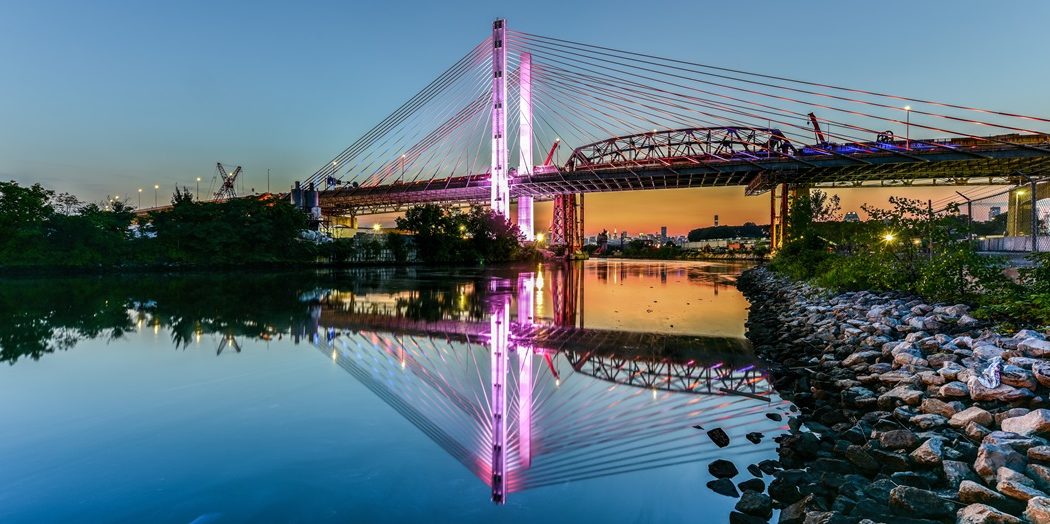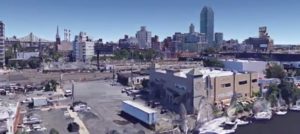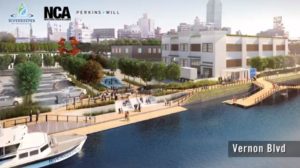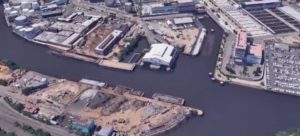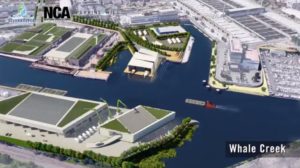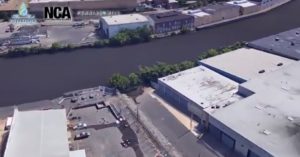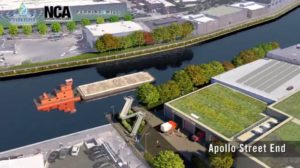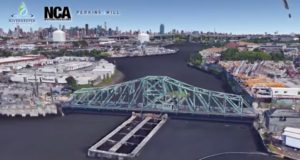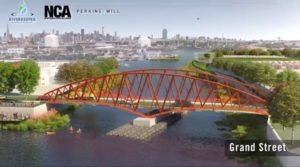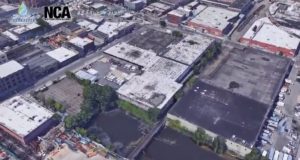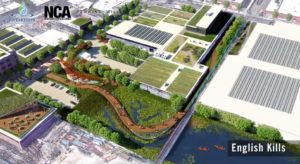On March 15, 2018, Riverkeeper, Newtown Creek Alliance, Guardians of Flushing Bay and the global architecture and design firm Perkins+Will’s New York Studio unveiled detailed plans to restore, revitalize and transform two of New York City’s most important, but often forgotten, waterfronts: Newtown Creek and Flushing Waterways.
The project is a first-of-its-kind planning effort in New York City.
It starts with improving the health of the water and ecosystem – restoring oyster reefs and marshes and wildlife, and building more natural, resilient shorelines.
It then expands into projects that foster recreation and connect neighborhoods with waterfronts that they’ve had too little access to.
The initiatives outlined in the plans can be summed up in four R’s: remediation, restoration, recreation and resilience.Inspired by numerous community meetings and idea-sharing workshops.
The plans are brimming with possibility: 135 opportunities to rehabilitate these neglected bodies of water, their shores and the communities they border.
Each plan is grounded in data and expertise on local environmental conditions, and informed by cultural and historical knowledge.Some of the listed projects are already underway.
Some of them revive long-held visions. Others are related to ambitious-but-achievable goals.
Here are a few examples of the possibilities along Newtown Creek (long degraded by industrial pollution), and the two connected waters of Flushing Bay and Flushing Creek (plagued by sewage overflows and largely cut off from nearby neighborhoods):
Newtown Creek:
- More “street-end parks,” where local workers and advocates have been transforming dead-end zones of crumbled concrete into community gardens and pocket parks;
- Permeable pavers and other green infrastructure to capture stormwater in the parking lots draining from industrial areas around Newtown Creek;
- Restored salt marsh features, including the one-time “Mussel Island,” made up largely of oysters and mussels, demolished in the 1930s to create an area large enough for barges and boats to turn around in the creek;
- Innovative bulkhead designs that protect the water from contamination and provide much-needed habitat, while serving the needs of industry. Designs include terraced bulkheads, decking over riprap, and gabions (wire frame structures filled with rock that allow marine wildlife such as mussels and marsh grasses to adhere and grow). Also living docks, floating wetlands;
- Oyster cages incorporated into pile fields on either side of a redesigned Grand Street Bridge.
Flushing Waterways:
- A community boathouse and educational facility at the site of an old pier on Flushing Bay promenade. The “Queens Water Exploration Center” is envisioned as a potential site for research, canoe and kayak rentals, and world class dragon boat racing;
- A large-scale oyster reef off LaGuardia Airport’s waterfront, which is restricted and inaccessible by design, and providing protected habitat for fish and birds, along with protection from storm surges. As the plan says, Flushing Bay and Creek “have the potential to be among the most productive ecosystems in the entire regional estuary”;
- Restoration of the waterfront, known as World’s Fair Marina, having been designed for the World’s Fairs of 1939 and 1964, and the historic “candela” structures on the promenade. (Today these historic sites are used largely as overflow parking for baseball and tennis events);
- Improved pedestrian bridges (with landscaping, green infrastructure and separate bike and pedestrian lanes) that connect neighborhoods like East Elmhurst, Jackson Heights and Corona with the nearby but difficult-to-reach waters of Flushing Bay, where parking lots and highway ramps dominate.
The plans are ambitious, but also doable, with the combined efforts of city parks and transportation officials, commercial property owners, academic and cultural programs, and grassroots advocates – all of whom contributed to the planning effort.
Once implemented, the plans would restore native salt marsh habitats, make the shores more accessible to the public for recreational activities, spur economic growth by creating employment opportunities, and help protect the areas from potential future floods and rising sea levels. Newtown Creek, located just across the East River from Midtown Manhattan, occupies an area of about 1,000 acres between Brooklyn and Queens. Flushing Waterways span 600 acres between LaGuardia Airport, Willets Point, downtown Flushing and Flushing Meadows Corona Park.
These plans will help assure that the billions being spent on remediation for these two waterways will be coupled with robust new commitments to habitat restoration, climate resilience and public recreation, as well, “These plans will help assure that the billions being spent on remediation for these two waterways will be coupled with robust new commitments to habitat restoration, climate resilience and public recreation, as well,” said Paul Gallay, Riverkeeper president. “Through our efforts, we hope to unify the diverse communities who live and work in these areas, and maintain healthier waterways and cleaner shorelines for generations to come.”
“The potential social, economic and environmental benefits of restoring these waterways and their abutting neighborhoods are significant,” says Mike Aziz, senior urban designer at Perkins+Will and co-leader of the planning process. “Our work creates a new model for urban industrial waterways that emphasizes resilience, remediation, recreation and restoration equally.”
The work is the culmination of more than 50 meetings and workshops with community members in which residents exchanged ideas and contributed opinions, says Aziz’s colleague and senior urban designer Daniel Windsor.
“We really got to know the people who live, work and spend time in these communities, and we learned a lot about what makes the waterways so valuable to them,” Windsor says. “Their active involvement and enthusiasm for the project were key, and really drove the entire process.”
From contamination to transformation: New Yorkers reimagine Newtown Creek
Newtown Creek has suffered from over a century of industrial contamination, including decades of oil seepage and chronic sewage overflows. America’s first oil refinery began operations along its banks in 1867, and the creek soon became one of the most heavily used — and polluted — waterways in the Port of New York. Today, the creek contains large amounts of various toxins within its sediments and is surrounded by numerous sources of upland contamination including the largest underground oil spill in U.S. history.
In 2010, Newtown Creek was made a part of the U.S. Environmental Protection Agency’s (EPA) Superfund program, through which the federal government manages toxic site remediation. Perkins+Will’s and Riverkeeper’s plan for the creek — which also received substantial input from the grassroots organization Newtown Creek Alliance — is intended to help the community prepare for the remediation and set broader social, environmental and economic goals. Solutions include stormwater infrastructure and habitat restoration, new public space, industrial redevelopment, and flood protection.
“Our focus was to outline transformative paths for Newtown Creek; ways to generate greater habitat, community access and sustainable use for decades to come. We hope the plan is an inspiration to local communities and to other urban waterways,” said Willis Elkins, program manager at Newtown Creek Alliance.
Other community ideas that had been previously pursued – such as the transformation of abandoned street-end areas into lush public spaces and the restoration of salt marsh within shallow tributaries – were also resurrected and further fleshed out as part of the plan.
Environmental pollution to innovative solution: Rethinking Queens’ great northern waterfront
Like Newtown Creek, the waterways around Flushing Bay are historic salt marshes, now overflowing with pollutants. To craft the plan for Flushing Waterways, Perkins+Will and Riverkeeper worked closely with Guardians of Flushing Bay, a group of local boaters, residents and environmental advocates. The plan envisions a renewed waterfront destination that connects the diverse communities of East Elmhurst, North Corona and Flushing with rapidly growing communities surrounding Flushing Bay, including the new Willets Point and Flushing West neighborhoods. It proposes extensive habitat restoration, the expansion of marshlands, a major new park space for downtown Flushing, reinvestment in the historic 1964 World’s Fair Marina and a new 40,000-square-foot Queens Waterfront Exploration Center.
The plan also identifies 50 ways to remediate the area’s pollution, restore waterfront access and spur reinvestment. These include creating water “trails,” making navigation easier for boaters and restoring the historic World’s Fair pavilions into park cafés. Long-term efforts identified in the plan include redesigning an existing two-mile public promenade and constructing a large-scale oyster reef that would border LaGuardia Airport.
“Our mission is to renew the Flushing waterfront and make it more accessible and relevant to the broader community,” says Akila Simon, Guardians of Flushing Bay board member. “This plan, and the plans for an ecology center and boathouse, showcase not only how Flushing Waterways can become an engine of economic revitalization, but also a vital, world-class waterway.”
Riverkeeper is grateful for the support of the funders who made these Vision Plans possible: the Doris Duke Charitable Foundation, The JPB Foundation, and the New York-New Jersey Harbor & Estuary Program. We also want to acknowledge our donors who generously support our efforts in New York City broadly, including the Lily Auchincloss Foundation and the Sun Hill Family Foundation.
The Visioning project itself could not have happened without the many partners who lent their unique voices, input, time and energy to the process, including Newtown Creek Alliance, Guardians of Flushing Bay, Waterfront Alliance, SWIM Coalition, Billion Oyster Project, LaGuardia Community College, Queens College, numerous New York City agencies and local officials, and dozens of local organizations in and around Flushing Bay and Newtown Creek.
Riverkeeper is a member-supported watchdog organization dedicated to defending the Hudson River and its tributaries and protecting the drinking water supply of nine million New York City and Hudson Valley residents. Since its beginnings more than 50 years ago, Riverkeeper has helped to establish globally recognized standards for waterway and watershed protection and serves as the model and mentor for the growing Waterkeeper movement that includes more than 300 Keeper programs around the globe.
The Newtown Creek Alliance is a community-based organization dedicated to restoring, revealing and revitalizing Newtown Creek. The organization works to restore community health, water quality, habitat, access, and vibrant commerce along Newtown Creek. Since 2002, the Alliance has served as a catalyst for effective community action, making a positive and enduring impact on the health and quality of life of Creek-side communities.
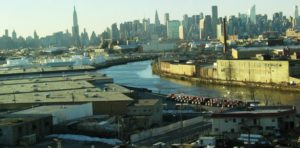
Newtown Creek flowing through Long Island City with NYC skyline in the background.
Photo by GK tramrunner via Wikipedia.
The Guardians of Flushing Bay are a coalition of human-powered boaters, environmental enthusiasts, community members, and advocates working toward a clean and healthy Flushing Bay in the Borough of Queens, New York City.
The Guardians’ mission also includes fighting for accessible and inviting waterways—from the Flushing Bay promenade and World’s Fair Marina to Flushing Creek and College Point.
These “Flushing Waterways” are the public’s space, and the Guardians seek to ensure that the public can make full and sustainable use of this historic waterfront ecosystem. The Guardians was founded in 2015 by members of the Empire Dragon Boat Team, which practices on the river.
Featured photo of Kosciuszko Bridge over Newtown Creek via Adobe Stock.
Before images via Google Earth.
After renderings courtesy of Perkins+Will.
Download full Newtown Creek Plan.
Download full Flushing Waterways plan.

